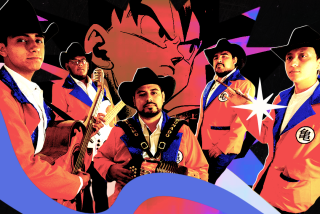JAPAN’S ‘POKEMAN’ HEADS WEST
- Share via
Coming this fall to a TV set near you--the show that felled several hundred kids.
In Japan, “Pokemon” is a top-rated children’s cartoon that has spawned $4 billion in commercial tie-in sales. Most Americans, however, know it only for an incident in December, when hundreds of Japanese children needed medical treatment after watching a segment that featured strobing colored lights.
By the fall, U.S. viewers will be able to see the show for themselves, when “Pokemon” becomes available in TV markets covering more than 85% of the country. The episode that caused seizures and other illnesses will not be shown.
The distributor vouches for the safety of “Pokemon,” but others have expressed concern after the December show resulted in 200 children being hospitalized. TV Guide referred to the episode as “dangerous TV.”
As with other Japanese imports, it remains to be seen whether “Pokemon” will follow the path of the “Mighty Morphin Power Rangers,” a live-action Japanese program that has fared amazingly well here, or of “Sailor Moon,” a cult cartoon favorite that failed to catch on with the larger American audience.
The Winter Olympic Games in Nagano are piquing interest in things Japanese, but Americans already are quite familiar with Japanese animation, a wide range of genres collectively known as anime. Much of the recent interest in anime has focused on adult genres, some featuring sex and violence.
Japanese cartoons have maintained a piece of the giant U.S. children’s cartoon market for more than three decades, dating back to the 1960s and “Astro Boy.” Baby-boomers watched “Gigantor,” “Kimba the White Lion,” “Eighth Man” and “Marine Boy,” while “Speed Racer,” another early import, has enjoyed a second life on MTV and now the Cartoon Network.
Interest in Japanese children’s programming enjoyed a renaissance in the past decade after Saban Entertainment succeeded with the “Mighty Morphin Power Rangers,” which featured Japanese action sequences spliced with scenes shot in the United States. Major U.S. studios now are working with Japanese animators. Disney is considering making a “Sailor Moon” movie, industry experts said.
Today, viewers can watch a smattering of syndicated Japanese cartoons, including “Dragon Ball Z” and “Robotech.” New, U.S.-produced episodes of “Voltron,” another Japanese crossover from the 1980s, are scheduled for the fall.
After production and broadcast in Japan, shows are dubbed, re-edited and, in some cases, repackaged for the United States. “Robotech,” which began appearing in the 1980s, is a compilation of three Japanese series.
“Pokemon” is an abbreviated Japanese pronunciation of “Pocket Monsters,” a Nintendo video game (which will be available in the United States in September.) The cartoon, in its second year in Japan, features 150 creatures who can transform into super-powered friends or monsters, depending upon the skills of their human trainers.
The show’s human heroes use the creatures to stop a group trying to conquer Earth. Pikachu, who shoots lightning bolts and looks like a yellow hamster with extended ears, is a cartoon and commercial star in Japan. Distributors hope Pikachu and friends enjoy merchandising success here, looking to the “Power Rangers” as an example of the great retail possibilities for a popular show.
More to Read
The biggest entertainment stories
Get our big stories about Hollywood, film, television, music, arts, culture and more right in your inbox as soon as they publish.
You may occasionally receive promotional content from the Los Angeles Times.










